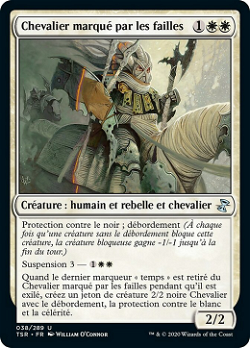À propos de Chevalier marqué par les failles
Chevalier marqué par les failles, Créature : humain et rebelle et chevalier, conçu par William O'Connor sorti pour la première fois en Feb, 2007 dans l'édition Planar Chaos et a été imprimé exactement dans 2 formes différentes. Il est actuellement vendu au prix le plus bas de C$ 0.01.
Cette carte bénéficierait d'un deck aggro ou midrange basé sur le blanc cherchant à mettre la pression sur l'adversaire tout en étant protégé contre les sorts et créatures noirs. Bien que Riftmarked Knight offre une capacité unique avec son mécanisme de Suspension et la génération de jetons, il peut ne pas être aussi efficace que d'autres options comme Mirran Crusader ou Hero of Bladehold en termes d'impact immédiat et de présence sur le terrain, ce qui en fait une inclusion situationnelle dans certaines stratégies de deck.
Des règles
19/03/21
As the second triggered ability resolves, you must cast the card if able. You must do so even if it requires targets and the only legal targets are ones that you really don’t want to target. Timing permissions based on the card’s type are ignored.
19/03/21
Exiling a card with suspend isn’t casting that card. This action doesn’t use the stack and can’t be responded to.
19/03/21
If the first triggered ability of suspend (the one that removes time counters) is countered, no time counter is removed. The ability will trigger again at the beginning of the card’s owner’s next upkeep.
19/03/21
If this is suspended, then when the last time counter is removed from it, both its triggered ability and the “cast this spell” part of the suspend ability will trigger. They can be put on the stack in either order.
19/03/21
If you cast a card “without paying its mana cost,” such as with suspend, you can’t choose to cast it for any alternative costs. You can, however, pay additional costs. If the card has any mandatory additional costs, you must pay those to cast the card.
19/03/21
Suspend is a keyword that represents three abilities. The first is a static ability that allows you to exile the card from your hand with the specified number of time counters (the number before the dash) on it by paying its suspend cost (listed after the dash). The second is a triggered ability that removes a time counter from the suspended card at the beginning of each of your upkeeps. The third is a triggered ability that causes you to cast the card when the last time counter is removed. If you cast a creature spell this way, it gains haste until you lose control of that creature (or, in rare cases, you lose control of the creature spell while it’s on the stack).
19/03/21
The converted mana cost of a spell cast without paying its mana cost is determined by its mana cost, even though that cost wasn’t paid.
07/06/13
A creature cast using suspend will enter the battlefield with haste. It will have haste until another player gains control of it (or, in some rare cases, gains control of the creature spell itself).
07/06/13
If the first triggered ability of suspend (the one that removes time counters) is countered, no time counter is removed. The ability will trigger again during the card’s owner’s next upkeep.
07/06/13
If the second triggered ability of suspend (the one that lets you cast the card) is countered, the card can’t be cast. It remains exiled with no time counters on it, and it’s no longer suspended.
07/06/13
If you can’t cast the card, perhaps because there are no legal targets available, it remains exiled with no time counters on it, and it’s no longer suspended.
01/02/07
If Riftmarked Knight is suspended, then when the last time counter is removed from it, both its own triggered ability and the “cast this card” part of the suspend ability will trigger. They can be put on the stack in either order.









— commentaires0
Soyez le premier à commenter